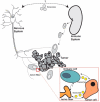A Holistic Perspective: Exosomes Shuttle between Nerves and Immune Cells in the Tumor Microenvironment
- PMID: 33142779
- PMCID: PMC7693842
- DOI: 10.3390/jcm9113529
A Holistic Perspective: Exosomes Shuttle between Nerves and Immune Cells in the Tumor Microenvironment
Abstract
One of the limitations of cancer research has been the restricted focus on tumor cells and the omission of other non-malignant cells that are constitutive elements of this systemic disease. Current research is focused on the bidirectional communication between tumor cells and other components of the tumor microenvironment (TME), such as immune and endothelial cells, and nerves. A major success of this bidirectional approach has been the development of immunotherapy. Recently, a more complex landscape involving a multi-lateral communication between the non-malignant components of the TME started to emerge. A prime example is the interplay between immune and endothelial cells, which led to the approval of anti-vascular endothelial growth factor-therapy combined with immune checkpoint inhibitors and classical chemotherapy in non-small cell lung cancer. Hence, a paradigm shift approach is to characterize the crosstalk between different non-malignant components of the TME and understand their role in tumorigenesis. In this perspective, we discuss the interplay between nerves and immune cells within the TME. In particular, we focus on exosomes and microRNAs as a systemic, rapid and dynamic communication channel between tumor cells, nerves and immune cells contributing to cancer progression. Finally, we discuss how combinatorial therapies blocking this tumorigenic cross-talk could lead to improved outcomes for cancer patients.
Keywords: exosomes; immune system; microRNAs; neurogenesis; neurotropic carcinoma; tumor microenvironment.
Conflict of interest statement
The authors declare no conflict of interest.
Figures

Similar articles
-
Exosome and mesenchymal stem cell cross-talk in the tumor microenvironment.Semin Immunol. 2018 Feb;35:69-79. doi: 10.1016/j.smim.2017.12.003. Epub 2017 Dec 27. Semin Immunol. 2018. PMID: 29289420 Free PMC article. Review.
-
Exosome-mediated communication in the tumor microenvironment contributes to hepatocellular carcinoma development and progression.J Hematol Oncol. 2019 May 29;12(1):53. doi: 10.1186/s13045-019-0739-0. J Hematol Oncol. 2019. PMID: 31142326 Free PMC article. Review.
-
The Crosstalk Between Tumor Cells and the Immune Microenvironment in Breast Cancer: Implications for Immunotherapy.Front Oncol. 2021 Mar 11;11:610303. doi: 10.3389/fonc.2021.610303. eCollection 2021. Front Oncol. 2021. PMID: 33777750 Free PMC article. Review.
-
Targeting the microenvironment in solid tumors.Cancer Treat Rev. 2018 Apr;65:22-32. doi: 10.1016/j.ctrv.2018.02.004. Epub 2018 Feb 22. Cancer Treat Rev. 2018. PMID: 29502037 Review.
-
The Roles of CD38 and CD157 in the Solid Tumor Microenvironment and Cancer Immunotherapy.Cells. 2019 Dec 20;9(1):26. doi: 10.3390/cells9010026. Cells. 2019. PMID: 31861847 Free PMC article. Review.
Cited by
-
Protein-based Radiopharmaceuticals that target fibroblast activation protein alpha: a review of current progress.EJNMMI Radiopharm Chem. 2025 Jun 21;10(1):32. doi: 10.1186/s41181-025-00356-5. EJNMMI Radiopharm Chem. 2025. PMID: 40542914 Free PMC article. Review.
-
Research advances on the immune research and prospect of immunotherapy in pituitary adenomas.World J Surg Oncol. 2021 Jun 5;19(1):162. doi: 10.1186/s12957-021-02272-9. World J Surg Oncol. 2021. PMID: 34090476 Free PMC article. Review.
-
Neuroscience in peripheral cancers: tumors hijacking nerves and neuroimmune crosstalk.MedComm (2020). 2024 Oct 31;5(11):e784. doi: 10.1002/mco2.784. eCollection 2024 Nov. MedComm (2020). 2024. PMID: 39492832 Free PMC article. Review.
-
Analysis of MicroRNA Expression Changes During the Course of Therapy In Rectal Cancer Patients.Front Oncol. 2021 Sep 2;11:702258. doi: 10.3389/fonc.2021.702258. eCollection 2021. Front Oncol. 2021. PMID: 34540669 Free PMC article.
-
Understanding the role of nerves in head and neck cancers - a review.Oncol Rev. 2025 Jan 20;18:1514004. doi: 10.3389/or.2024.1514004. eCollection 2024. Oncol Rev. 2025. PMID: 39906323 Free PMC article. Review.
References
-
- Dagenais G.R., Leong D.P., Rangarajan S., Lanas F., Lopez-Jaramillo P., Gupta R., Diaz R., Avezum A., Oliveira G.B.F., Wielgosz A., et al. Variations in common diseases, hospital admissions, and deaths in middle-aged adults in 21 countries from five continents (PURE): A prospective cohort study. Lancet. 2020;395:785–794. doi: 10.1016/S0140-6736(19)32007-0. - DOI - PubMed

